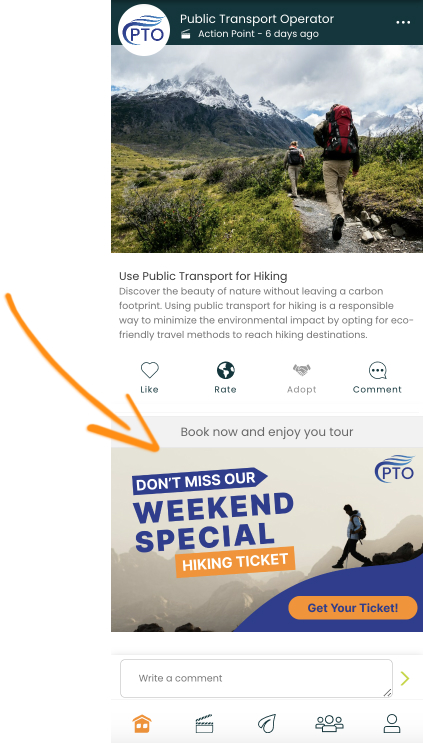In today’s world, sustainability is not just a trend but a crucial element of business strategy. Consumers are increasingly conscious of the environmental impact of their choices, and companies are under pressure to demonstrate their commitment to Corporate Social Responsibility (CSR). This shift has paved the way for innovative marketing approaches, and one such groundbreaking method is responsible product placement through impactful actions.
Introducing Responsible Product Placement (RPP)
Imagine a marketing approach where the message is not primarily about selling a product, but also about promoting a more responsible lifestyle. This is the essence of responsible product placement. It’s a strategy that integrates product promotion with sustainability action, offering consumers practical advice on conscious living while highlighting the company’s relevant products and services.
Example in Action: Consider a public transport operator encouraging its community to take public transport for a hiking trip. The message of the action might read: “Discover the beauty of nature without leaving a carbon footprint”. By communicating this sustainable action across different touchpoints, the public transport operator not only highlights the ease and enjoyment of using public transport, but also emphasizes the sustainability benefits compared to driving, allowing you to relax and enjoy the journey guilt-free.
To further entice the community, the operator offers a special weekend hiking ticket at a discount in connection with this action, making it even easier and more appealing for people to choose a greener option. This approach seamlessly integrates a sustainable action for the community with a practical, attractive offer, effectively promoting the use of public transport while aligning with the values of eco-conscious consumers.

The Authenticity of Responsible Marketing
In an age where consumers are bombarded with advertisements and marketing messages, authenticity has become a crucial differentiator for brands. Traditional advertising methods are increasingly viewed with skepticism, as consumers crave genuine connections and transparency from the brands they support. Responsible product placement taps into this desire for authenticity by aligning marketing messages with the values and lifestyles of eco-conscious consumers.
Consider the example of the public transport operator. By packaging the product placement with a sustainable action, it is not perceived as traditional advertising by the recipients in first hand. Instead, the public transport operator fosters a stronger relationship with consumers by offering them a service that match their values of sustainability and environmental stewardship.
Implementing Responsible Product Placement
When considering responsible product placement, choosing the right tool is crucial for maximizing impact and authenticity. Once a suitable tool has been found, consider the following steps to effectively integrate responsible product placement into your marketing strategy:
1. Identify Relevant Actions: Begin by identifying sustainability tips that resonate with your brand and target audience. These tips should align with your products or services and reflect your commitment to environmental stewardship.
2. Make the Actions Vivid and Tangible: Ensure that the sustainability actions you provide are vivid, easy to understand and tangible. Use compelling visuals, headlines and stories to bring the actions to life, making it easier for consumers to engage and act on them. To do so, planeed might be a helpful tool for you.
3. Highlight the Benefits: Clearly communicate the environmental and personal benefits of adopting the suggested sustainable practices. This helps consumers understand the positive impact of their choices.
4. Create Concrete Offers: Develop compelling offers that encourage consumers to act on the sustainability tips provided. These offers should be practical and appealing, motivating consumers to make eco-friendly choices while also benefiting from your products or services.
5. Leverage Multiple Channels: Utilize a variety of marketing channels to amplify your message. This includes digital platforms, social media, email newsletters, and even physical signage or promotions at relevant locations. Consistent and widespread communication enhances visibility and reinforces your brand’s commitment to sustainability.
6. Measure and adapt: Monitor the effectiveness of your sustainable action through metrics such as customer engagement, perceived impact, and likelihood to adopt. Use this data to refine your strategies and adapt your action to better meet consumer expectations and the effectiveness of your product placement.
Conclusion
Responsible product placement is more than just a marketing tactic; it’s a commitment to authenticity, responsibility, and innovation. By integrating specific offerings into sustainability actions, companies can not only promote their products in a highly relevant context, but also make a positive contribution to their brand image. This approach is particularly effective with today’s increasingly sustainability-conscious consumers, making it a powerful strategy for modern marketers. planeed stands at the forefront as a pioneering tool, uniquely blending authentic CSR communication with responsible product placement through innovative features tailored for the modern market’s corporate and social responsibility landscape.
Related Posts
Related Posts
Corporate Social Responsibility (CSR) has evolved from a peripheral concern to a central component of modern business strategy. Today’s stakeholders — customers, …
CSR Initiatives That No One Uses Bright Future Inc., a globally operating company based in the U.S. with over 10.000 employees, has …
Brands that matter today don’t just report their values — they make them authentic, engaging and something to talk about. They rely …



